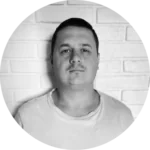The recent pandemic’s impact on the healthcare industry was harsh. However, it also brought new opportunities. During that time, we saw a rise in the popularity of digital health solutions. These solutions revolutionized healthcare, allowing patients to consult doctors remotely via video calls or messages. More importantly, they slashed operating costs for healthcare providers.
Today, the telehealth market is still growing steadily and is expected to reach $513.8 billion USD by 2030. But how do you break into this profitable market? In this article, we will discuss everything you need to know about telehealth app development, its features, and best practices.
Getting Started With Telehealth App Development
Telehealth apps are platforms that offer healthcare professionals and patients to communicate remotely with each other. Depending on the app, this can happen via video calls or messages.
The main goal of telehealth solutions is to make healthcare more accessible and reduce clinics’ operational costs. Such apps are purposefully designed to be as accessible and user-friendly as possible since they target patients of all ages at once.
Patients can get all the necessary services from the comfort of their homes instead of making a trip to the clinic. At the same time, doctors can better schedule their working hours and, since distance is not a concern, can expand their reach.
Recently, we conducted a survey among healthcare and wellness companies in order to understand where the future of the wellness industry lies, and here are the results:

As you can see, 75% of respondents said that the future of the wellness industry lies in the increased integration of technology and digital health applications.
The second question we asked was about important factors for businesses to create a seamless digital patient experience and build a consistent brand image.
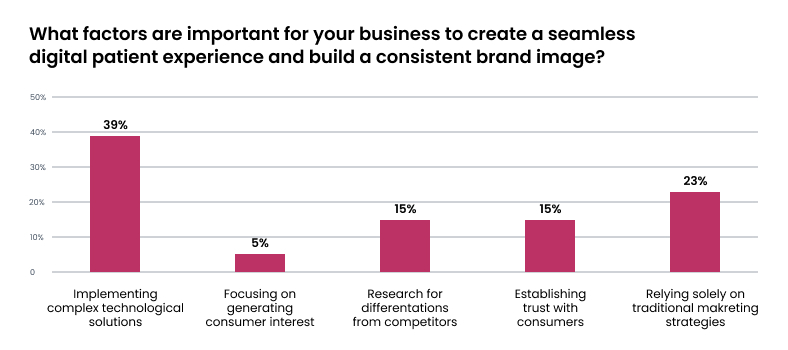
39% of recipients believe in the importance of implementing complex technological solutions, while only 23% prefer traditional marketing strategies.
Based on the results, we can see that more businesses think the future is in adopting technological solutions. But why is that? Let’s talk about why they think telehealth is so important.
mHealth App Development: The Complete Guide
Read more
The Importance of Telehealth Apps
The importance of telehealth solutions comes from covering key gaps that reveal weak points in the healthcare industry. Some of them are:
- A patient lives in a remote area and can’t easily access healthcare services;
- Lack of accessibility features for immobile patients;
- Overcrowded clinics due to lack of staff
- The challenge of processing paperwork.
Telehealth software easily mitigates all of these problems. It provides a way for people to get healthcare even if they live in remote areas or are immobile. On top of that, it can reduce the number of people making offline appointments by presenting an alternative way of getting the same service.
But what can they actually do? Let’s talk about it.
Key Features of Telehealth Apps
Telehealth apps are packed with many useful features. But just talking about them without an actual presentation of how they work would be boring. Luckily, we at CHI Software have experience creating such solutions.
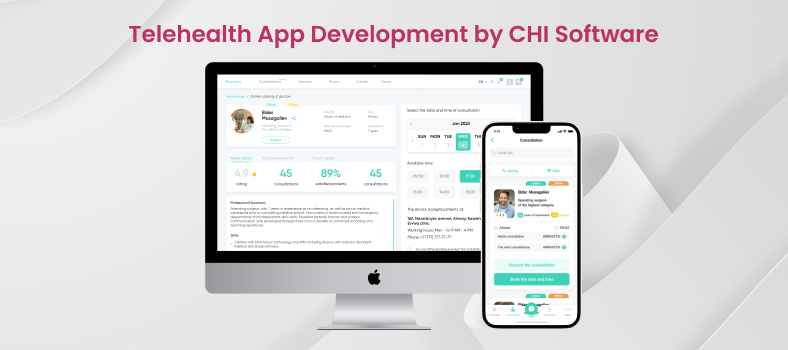
One of our clients from Central Asia had a goal to create automated software with diverse functionality for healthcare professionals. The main challenges were:
- To create and support a high-load healthcare data platform with many end-users;
- To synchronize all platforms, such as web, desktop, and mobile;
- To find a team for custom healthcare software development.
Developing Wellness Apps for Seniors: Accessibility and Usability Considerations
Read more
Our case study looks at all of the elements that CHI Software needed to develop a telehealth platform for our client:
User Registration
The first step that users experience is the registration process. A patient’s dedicated account holds all their relevant information and ensures doctors can securely access everything they need to know about the patient while keeping the data secure.
At initial registration, the patient needs to fill in the form with information about their medical history, such as previous diagnoses and surgeries. The doctors will have access to this information, ensuring they can provide the best possible treatment.
In addition, already registered users have to log in to their account, which connects every user to their profile. The registration system prevents access to information with malicious intent, as it will be seen only by the patient and their doctors.
Video Consultation
Another feature at the core of any telemedicine software solution is video consultation. It enables doctors and patients to communicate as if they were in the same room. There are two main reasons why it’s so important.
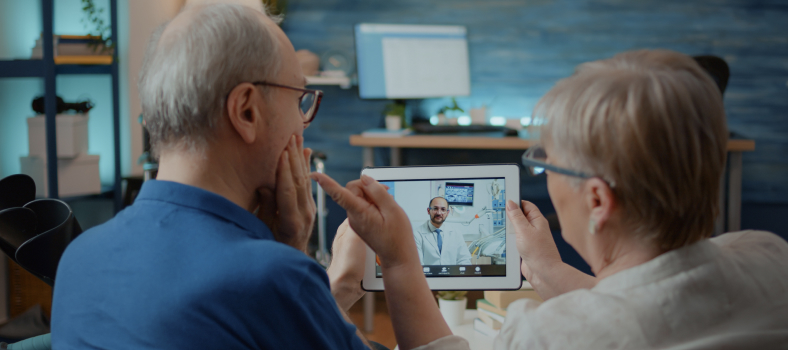
Firstly, doctors can visually assess the patient. This is needed since not every patient knows what that weird rash on their hand could mean.
Secondly, discussing symptoms and providing diagnosis mimics face to face meetings. Minimalistic interfaces and technologies for high quality video also enhance the experience.
To ease information exchange, the video consultation interface comes with a chat box where the user can share images and files with their doctor.
Payment Gateway Integration
Doctors need to be compensated for their work. That’s where payment gateway integration comes in, allowing each patient to pay their doctors, with a small fee from the platform.
This feature becomes especially useful with integration of the most popular payment methods – credit or debit cards and digital wallets. This solution ensures secure payment transfers and provides patients with digital receipts.
Usually, payment integration also provides users with access to their previous transaction history. Additionally, it encourages a flexible pricing model based on the types of services doctors provide. This way, every doctor can be compensated for their work fairly, and patients know exactly what they are paying for.
The 15 Ways to Implement Machine Learning in Healthcare
Read more
In-App Chat and Call
Not every appointment needs to be a video call. That’s why eHealth solutions allow users to write text messages to doctors, schedule calls for non-urgent queries, or have a discussion to clarify their treatment. This is especially useful for patients and doctors who experience connectivity issues because it provides them with the ability to follow up asynchronously.
Another difference between video calls and chats is scheduling. Patients don’t have to schedule texting with doctors since doctors answer texts at their own convenience.
This feature promotes collaboration between patients and doctors. Doctors can share educational resources or articles to help patients better understand their diagnoses. At the same time, patients can upload images or reports for doctors to review and provide guidance.
It's not always easy to come up with an ideal set of features. But we're here to make complex tasks easier!
Let's discuss your project
Prescription and Pharmacy Integration
After a consultation with a doctor, patients usually expect them to recommend some medication. This is why prescription and pharmacy integration is another useful feature of telehealth software.
Prescription integration helps patients to get information about their medication in electronic form. Compared to verbal prescriptions, it reduces the chances of errors due to a lack of proper communication.
When doctors prescribe drugs through the app, the prescription is automatically sent to the patient. Some eHealth solutions also integrate with pharmacies.
In the case of CHI Software’s telehealth app solution, prescriptions are also sent to the pharmacy, which can prepare the medication and arrange delivery, thus eliminating the need for a patient to go physically to the pharmacy.
Appointment Scheduling
Doctors want to control their working hours and see how many patients they will have throughout the day. At the same time, patients want to see which time slots the doctor will be available and plan out their day accordingly.
The strongest point of appointment scheduling is that it’s a much easier process. Instead of physically going to the hospital to find out the doctor’s available hours, you can just open your phone and schedule an appointment in the app.
This is achieved by making the process as intuitive as possible. The interface clearly shows every available time slot and how to schedule an appointment. It is made specifically user-friendly so patients of all ages can access it.
Additional Features
Some telehealth apps expand on these functionalities:
- Group calls: Sometimes, there is a need to connect multiple people to one call. This way, specialists can talk to each other in real-time to discuss the patient’s condition;
- Integration with electronic health records (EHRs): In addition to the form patients need to fill out during registration, a telehealth app can integrate their EHR. This will give doctors more comprehensive information about their patient’s medical histories;
Gamification in Wellness Apps: Keeping Users Engaged and Motivated
Read more
- Integration with wearable technology: This can allow doctors to analyze patients’ vitals in real time. With just one click, the doctor can know the patient’s heart rate or other information from the wearable tech;
- AI-powered chatbots: This feature is gaining popularity throughout many industries. In eHealth products, such chatbots can schedule appointments for patients and provide them with 24/7 support.
The list of features of telehealth apps is extensive. But how do you build one for your business?
The 10 Steps of the eHealth Software Development Process
As with any type of software development, eHealth solutions require a lot of planning before their execution. The key difference here is that you will need to take additional steps to comply with regulations in the healthcare industry.
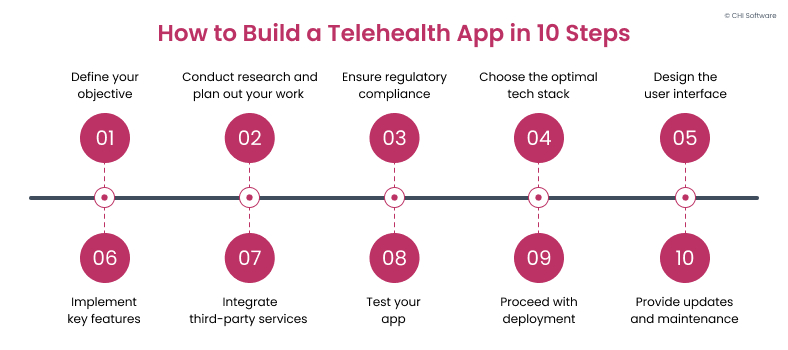
Let’s talk about how the healthcare app development cycle looks:
Step 1: Define your objective
Like with any software, success depends on clearly identifying your goals. Think about who this product is for, what its purpose is, and what it can do. Luckily, we already have covered all of the potential features you might be interested in above.
Step 2: Conduct research and plan out your work
Once all your ideas are written down, it’s time to research. Start by looking into solutions that already exist and identifying the user’s needs. Outlining a product roadmap based on your research will help you explain how the software you are creating will benefit patients and doctors.
Step 3: Ensure regulatory compliance
This step is what makes working with an eHealth app different from other apps. Each country has its own set of rules and regulations regarding the healthcare industry that you need to abide by. You need to study and understand them. This is done to provide the end users with a product that is compliant with current regulations.
Step 4: Choose the right technological stack
To start, you need to decide which technology stack to use. The choice of a tech stack varies based on scalability requirements, the development team’s expertise, and budget. A standard technology staсk includes the following:
- Front-end framework and programming language;
- Back-end framework and programming language;
- Database;
- Hosting Infrastructure;
- Other tools.
Step 5: Design the user interface (UI)
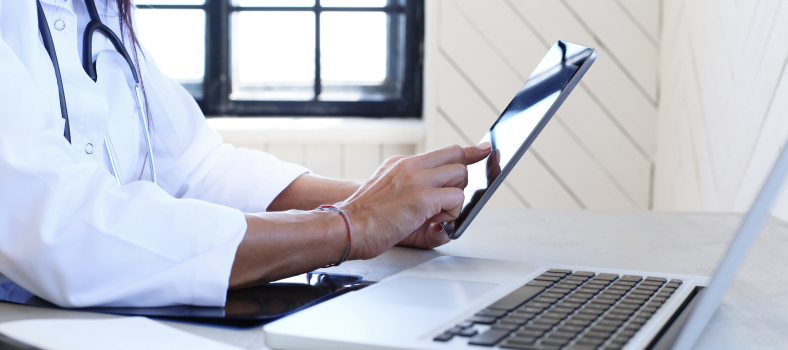
Having a good user interface is crucial. But how do you define “good,” and where should you focus? Let’s cover some points:
- The color scheme of the app should align with your branding and image;
- Remember who your target audience is. Your healthcare mobile app design should be easy to navigate;
- The fonts you are using should be readable from the mobile screen;
- The user interface should have consistent design rules. For example, if one cancel button is red, every cancel button must be red.
Step 6: Implement key features
Now that we have the UI design, it’s time to implement the product’s core features. Focus on providing your end users with quality features: prioritize high-quality audio and video and ensure security by adding encryption and an authentication system.
Step 7: Integrate third-party services
We’re almost done with the development. All that is left is to integrate third-party services of your choosing. Such services will provide your software with additional functionalities. Here are some examples:
- Payment systems;
- Analytics tools;
- Language translation services;
- Electronic health records.
Step 8: Test your app
Testing your software is essential. If the software has critical bugs, no one is going to use it. So, let’s talk about what you need to focus on:
- Ensure the app meets quality standards;
- Test if all features work properly;
- Check if the integrated systems respond correctly;
- Monitor the state of security measures.
After the app’s tests are done, you are ready for the next stage of development.
Step 9: Proceed with the deployment
Deployment is the pinnacle of the development process. Deployment (also known as product launch) is the moment when you make your app available to the end users. Here are the key steps to this process:
- Ensure the app functions correctly before launch;
- Make the app available for the users;
- Monitor software’s performance in the real world and address any critical problems users might encounter.
Step 10: Provide updates and maintenance
If you want your app to keep on bringing value to your company, you need to maintain it, which includes several key points:
- Fixing bugs users encounter;
- Continuing to monitor software performance;
- Constantly updating security measures to the latest standards;
- Developing new features or quality-of-life changes based on user feedback.
We have outlined a rough guide for virtual health app creation, so that you know what to expect. Each development team has their own approach to this process, which is why you should talk to your vendor about the project workflow and the estimated time each step will take.
That’s almost all! The only thing left to cover is security.
Best Practices for Secure Telemedicine App Development
When talking about eHealth software development, the importance of taking proper security measures cannot be overstated. You need to realize that you work with patients’ sensitive data and protect it accordingly. Here, we have gathered some helpful tools and approaches.

User authentication system: You need a strong system that will link users with their existing profiles. To minimize risks of unauthorized access to the data, look into implementing two-factor or biometric authentication.
Secure data storage: All sensitive data should be stored in an encrypted database with access controls. This will prevent unauthorized access on the server side.
Regular security audits: Ideally, you should review the security of your data every few months. This will allow you to detect and mitigate any weak points in your security.
Secure APIs: Another thing to be mindful of is the APIs you are using. You need to check if they follow the best data protection practices in order to have an uncompromised system.
Secure communication channels: Since data can potentially be intercepted by malicious actors, use secure communication channels for data transmission.
How to Create a Health Insurance Mobile Application
Read more
Data backup and recovery: Always have an up-to-date backup of the database and create a plan for data recovery in case of a security breach or data loss.
Staff education: Social engineering is the easiest way for hackers to access your data. You need to keep your staff educated on this matter to prevent phishing attempts.
Final Words
Telehealth apps are a great tool for doctors and patients. In this article, we have discussed why they are important, what features they offer users, and how to develop such software for your business.
While eHealth products can be very profitable, they aren’t easy to make. If you don’t have enough expertise in the field, you should seek someone who has it. Luckily for you, we at CHI Software have this expertise and can provide you with medical app development services. Contact us today, and get ready to improve your business tremendously!
FAQs
-
What is telehealth app development?

It’s a process of creating a software to connect doctors and patients remotely. With these apps, doctors expand their reach to new patients while patients get healthcare services even in remote places.
-
What are the key features of a successful telehealth app?

The key features of the eHealth software include:
User integration;
Video consultation;
Payment gateway integration;
In-app chats;
Prescription and pharmacy integration;
Appointment scheduling.
-
What regulations must telehealth apps comply with?

Regulations vary depending on the country in which you want to deploy your telehealth app. For example, if you are developing such software for the US, you must comply with HIPAA, and if you are in the EU, you must deal with GDPR. On top of that, every country has its own local variation of data protection laws and medical device regulations you need to abide by.
-
What technologies are driving telehealth app development today?

Several technologies stand out. Firstly, wearable technology. It performs remote patient monitoring and sends data to the doctors. Secondly, AI technologies – more specifically, machine learning and natural language processing – provide users with personalized recommendations and automate some tedious work.
-
Can telehealth apps integrate with existing healthcare systems?

Yes, they can! There are three ways to do that:
Electronic health record integration makes it easier for doctors and patients to exchange information about medical history;
Appointment scheduling will simplify patients’ routines and help doctors control their working hours.
ePrescriptions can be stored on the patient’s account with no chance of losing them.
About the author
With 5 fabulous years under his belt, Artem is an iOS developer with experience in everything from healthcare and social apps to food & booking platforms and even entertainment. He's a wizard at crafting apps that are not just easy to use but totally engaging. Whether Artem's building an app from square one or stepping in mid-project, he's a go-to expert for making digital magic happen.
Rate this article
22 ratings, average: 4.5 out of 5

